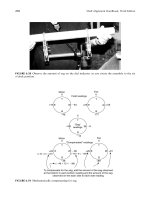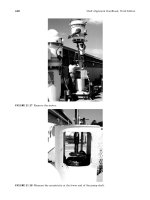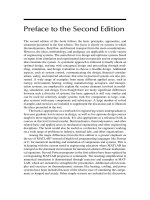Design and Optimization of Thermal Systems Episode 3 Part 1 pot
Bạn đang xem bản rút gọn của tài liệu. Xem và tải ngay bản đầy đủ của tài liệu tại đây (237.99 KB, 25 trang )
473
8
Lagrange Multipliers
8.1 INTRODUCTIONTO CALCULUSMETHODS
We are all quite familiar, from courses in mathematics, with the determination of
the maximum or minimum of a function by the use of calculus. If the function is
continuous and differentiable, its derivative becomes zero at the extremum. For a
function y(x), this condition is written as
dy
dx
0
(8.1)
where x is the independent variable. The basis for this property may be explained
in terms of the extrema shown in Figure8.1. As the maximum at point A is
approached, the value of the function y(x) increases and just beyond this point,
it decreases, resulting in zero gradient at A. Similarly, the value of the function
decreases up to the minimum at point B and increases beyond B, giving a zero
slope at B. In order to determine whether the point is a maximum or a minimum,
the second derivative is calculated. Since the slope goes from positive to negative,
through zero, at the maximum, the second derivative is negative. Similarly, the
slope increases at a minimum and, thus, the second derivative is positive. These
conditions may be written as (Keisler, 1986)
For a maximum:
dy
dx
2
2
0 (8.2)
For a minimum:
dy
dx
2
2
0
(8.3)
These conditions apply for nonlinear functions y(x) and, therefore, calculus meth-
ods are useful for thermal systems, which are generally governed by nonlinear
expressions. However, both the function and its derivative must be continuous for
the preceding analysis to apply.
Thus, by setting the gradient equal to zero, the locations of the extrema
may be obtained and the second derivative may then be used to determine the
nature of each extremum. There are cases where both the rst and the sec-
ond derivatives are zero. This indicates an inection point, as sketched in
Figure8.1(c), a saddle point, or a at curve, as in a ridge or valley. It must be noted
that the conditions just mentioned indicate only a local extremum. There may be
several such local extrema in the given domain. Since our interest lies in the overall
maximum or minimum in the entire domain for optimizing the system, we would
474 Design and Optimization of Thermal Systems
seek the global extremum, which is usually unique and represents the largest or
smallest value of the objective function. The following simple example illustrates
the use of the preceding procedure for optimization.
Example 8.1
Apply the calculus-based optimization technique just given to the minimization of
cost C for hot rolling a given amount of metal. This cost is expressed in terms of the
mass ow rate
m of the material as
Cm
m
35
14 8
14
22
.
.
.
.
where the rst term on the right-hand side represents equipment costs, which
increase as the ow rate increases, and the second term represents the operating
costs, which go down as
m increases.
Solution
The extremum is given by
dC
dm
mm
( . )( . ) ( . )( . )
.
35 14 148 22
49
04 32
mm
04 32
32 56 0
.
Therefore,
m
¤
¦
¥
³
µ
´
32 56
49
1 692
136
.
.
.
/.
The second derivative is obtained as
dC
dm
mm
2
2
06 42
1 96 104 19
A
y(x)
x
(a) Maximum (b) Minimum (c) Inflection point
B
C
FIGURE 8.1 Sketches showing a maximum, a minimum, and an inection point in a
function y(x) plotted against the independent variable x.
Lagrange Multipliers 475
which is positive because the ow rate
m
is positive. This implies that the optimi-
zation technique has yielded a minimum of the objective function C, as desired.
Therefore, minimum cost is obtained at
m
1.692, and the corresponding value
of C is 11.962.
The preceding discussion and the simple example serve to illustrate the use of
calculus for optimization of an unconstrained problem with a single independent
variable. However, such simple problems are rarely encountered when dealing
with the optimization of practical thermal systems. Usually, several independent
variables are involved and constraints may have to be satised. This consider-
ably complicates the application of calculus to extract the optimal solution. In
addition, the use of calculus methods requires that any constraints in the problem
must be equality constraints. This limitation is often circumvented by convert-
ing inequality constraints into equality ones, as outlined in Chapter 7. In many
practical circumstances, the objective function is not readily available in the form
of continuous and differentiable functions, such as the one given in Example 8.1.
However, curve tting of numerical and experimental data may be used in some
cases to yield continuous expressions that characterize the given system and that
can then be used to obtain the optimum.
Calculus methods, whenever applicable, provide a fast and convenient method
to determine the optimum. They also indicate the basic considerations in optimi-
zation and the characteristics of the problem under consideration. In addition,
some of the ideas and procedures used for these methods are employed in other
techniques. Therefore, it is important to understand this optimization method
and the basic concepts introduced by this approach. This chapter presents the
Lagrange multiplier method, which is based on the differentiation of the objec-
tive function and the constraints. The physical interpretation of this approach
is brought out and the method is applied to both constrained and unconstrained
optimization. The sensitivity of the optimum to changes in the constraints is dis-
cussed. Finally, the application of this method to thermal systems is considered.
8.2 THE LAGRANGEMULTIPLIERMETHOD
This is the most important and useful method for optimization based on calculus.
It can be used to optimize functions that depend on a number of independent
variables and when functional constraints are involved. As such, it can be applied
to a wide range of practical circumstances provided the objective function and the
constraints can be expressed as continuous and differentiable functions. In addi-
tion, only equality constraints can be considered in the optimization process.
8.2.1 B ASIC APPROACH
The mathematical statement of the optimization problem was given in the preced-
ing chapter as
U(x
1
, x
2
, x
3
, , x
n
) l Optimum (8.4)
476 Design and Optimization of Thermal Systems
subject to the constraints
G
1
(x
1
, x
2
, x
3
, , x
n
) 0
G
2
(x
1
, x
2
, x
3
, , x
n
) 0
%
G
m
(x
1
, x
2
, x
3
, , x
n
) 0
(8.5)
where U is the objective function that is to be optimized and G
i
0, with i vary-
ing from 1 to m, represents the m equality constraints. As mentioned earlier, if
inequality constraints arise in the problem, these must be converted into equality
constraints in order to apply this method. In addition, in several cases, inequality
constraints simply dene the acceptable domain and are not used in the optimiza-
tion process. Nevertheless, the solution obtained is checked to ensure that these
constraints are satised.
The method of Lagrange multipliers basically converts the preceding problem
of nding the minimum or maximum into the solution of a system of algebraic
equations, thus providing a convenient scheme to determine the optimum. The
objective function and the constraints are combined into a new function Y, known
as the Lagrange expression and dened as
Y(x
1
, x
2
, , x
n
) U(x
1
, x
2
, , x
n
) L
1
G
1
(x
1
, x
2
, , x
n
) L
2
G
2
(x
1
, x
2
, , x
n
)
z
L
m
G
m
(x
1
, x
2
, , x
n
)(8.6)
where the L’s are unknown parameters, known as Lagrange multipliers . Then,
according to this method, the optimum occurs at the solution of the system of
equations formed by the following equations:
t
t
t
t
t
t
Y
x
Y
x
Y
x
n12
00 0$ (8.7a)
t
t
t
t
t
t
YY Y
m
LL L
12
00 0$ (8.7b)
When these differentiations are applied to the Lagrange expression, we nd that
the optimum is obtained by solving the following system of equations:
t
t
t
t
t
t
t
t
t
t
U
x
G
x
G
x
G
x
U
x
m
m
1
1
1
1
2
2
11
2
0LL L
L
$
11
1
2
2
2
22
1
1
0
t
t
t
t
t
t
t
t
t
t
G
x
G
x
G
x
U
x
G
m
m
n
LL
L
$
%
xx
G
x
G
x
nn
m
m
n
t
t
t
t
LL
2
2
0$
Lagrange Multipliers 477
G
1
(x
1
, x
2
, x
3
, . . . , x
n
) 0
G
2
(x
1
, x
2
, x
3
, . . . , x
n
) 0 (8.8)
%
G
m
(x
1
, x
2
, x
3
, . . . , x
n
) 0
If the objective function U and the constraints G
i
are continuous and differen-
tiable, a system of algebraic equations is obtained. Since there are m equations for
the constraints and n additional equations are derived from the Lagrange expres-
sion, a total of m n simultaneous equations are obtained. The unknowns are the
m multipliers, corresponding to the m constraints, and the n independent vari-
ables. Therefore, this system may be solved by the methods outlined in Chapter 4
to obtain the values of the independent variables, which dene the location of
the optimum, as well as the multipliers. Analytical methods for solving a system
of algebraic equations may be employed if linear equations are obtained and/or
when the number of equations is small, typically up to around ve. For nonlinear
equations and for larger sets, numerical methods are generally more appropriate.
The optimum value of the objective function is then determined by substituting
the values obtained for the independent variables into the expression for U. The
optimum is often represented by asterisks, i.e., x
1
*
, x
2
*
, , x
n
*
, and U
*
.
8.2.2 PHYSICAL INTERPRETATION
In order to understand the physical reasoning behind the method of Lagrange mul-
tipliers, let us consider a problem with only two independent variables x and y and a
single constraint G(x, y ) 0. Then the optimum is obtained by solving the equations
t
t
t
t
t
t
t
t
U
x
G
x
U
y
G
y
Gxy
L
L
0
0
0(,)
(8.9)
The rst two equations can be written in vector notation as
U L G 0(8.10)
where is the gradient vector. The gradient of a scalar quantity F(x,y ) is
dened as
t
t
t
t
F
FF
xy
ij
(8.11)
where i and j are unit vectors in the x and y directions, respectively.
Therefore, F is a vector with the two partial derivatives tF/tx and tF/ty as the
478 Design and Optimization of Thermal Systems
two components in these directions. For example, if the temperature T in a region
is given as a function of x and y, the rate of change of T in the two coordinate
directions is the components of the gradient vector T. This vector is used
effectively in heat conduction to represent the heat ux vector q, which is given
as q kT from Fouriers Law, k being the thermal conductivity. This heat ux
vector is used to determine the rate of heat transfer in different coordinate direc-
tions (Gebhart, 1971).
GradientVector
Let us consider the gradient vector further in order to provide a graphical rep-
resentation for the method of Lagrange multipliers. This discussion will also be
useful in other optimization schemes that are based on the gradient vector. From
the denition of F and from calculus, the magnitude and direction of the gradi-
ent vector, as well as a unit vector n in its direction, may be calculated as
|| (/)(/) tan
/
/
tt tt
tt
tt
Đ
â
ă
ả
FF F Q
F
F
xy
y
x
22 1
áá
ã
tt tt
tt tt
,
(/) (/)
(/) (/)
n
ijFF
FF
xy
xy
22
(8.12)
where | F| is the magnitude of the gradient vector and Q is the inclination with
the x-axis.
Let us now consider a F constant curve in the x-y plane, as shown in
Figure8.2 for three values c
1
, c
2
, and c
3
of this constant. Then, from the chain
rule in calculus,
d
x
dx
y
dyF
FF
t
t
t
t
(8.13)
For F constant, dF 0. If this condition is used to represent movement along
the curve, we get
dx dy
y
x
tt
tt
Ô
Ư
Ơ
à
F
F
/
/
(8.14)
Therefore, the tangential vector T shown in Figure8.2, may be obtained by
using a differential element dT is given by this relationship between dx and dy.
Therefore,
ddxdydy
y
x
dyTij ij
tt
tt
Ô
Ư
Ơ
à
F
F
/
/
(8.15)
Lagrange Multipliers 479
The unit vector t along the tangential direction may be obtained, as done previ-
ously for the gradient vector, by dividing the vector by its magnitude. Thus,
t
ij
tt
tt
tt
tt
¤
¦
¥
³
µ
´
dy
y
x
dy
dy
y
x
d
F
F
F
F
/
/
/
/
(
2
yy
yx
xy
)
(/) (/)
(/) (/)
2
22
t t t t
tt tt
FF
FF
ij
(8.16)
Thus it is seen that the two vectors n and t may be represented as
n c i dj and t d i cj (8.17)
where c and d represent the respective components given in the preceding
equations. The relationship given by Equation (8.17) applies for vectors that are
normal to each other. This is shown graphically in Figure8.3(a). Mathematically,
if a dot product of two vectors that are perpendicular to each other is taken, the
result should be zero. Applying the dot product to n and t, we get
n
.
t (c i d j)
.
( d i cj ) cd cd 0(8.18)
since i and j are independent of each other. This conrms that the two vec-
tors t and n are perpendicular. Therefore, the gradient vector F is normal to
the constant F curve, as shown in Figure8.3(b). This information is useful in
FIGURE 8.2 Contours of constant F shown on an x-y plane for different values of the
constant. Also shown is the tangent vector T, which is tangential to one such contour.
Tangent
vector
T
y
dy
φ = c
3
φ = c
4
φ = c
2
φ = c
1
dφ = 0
dx
x
480 Design and Optimization of Thermal Systems
understanding the basic characteristics of the Lagrange multiplier method and for
developing other optimization techniques, as seen in later chapters.
If three independent variables are considered, a surface is obtained for a con-
stant value of F. Then, the gradient vector F is normal to this surface. Similar
considerations apply for a larger number of independent variables. The gradient
F may be written for n independent variables as
t
t
t
t
t
t
t
t
F
FFF F
xx x x
n1
1
2
2
3
3
iii i
n
$
(8.19)
where i
1
, i
2
, , i
n
are unit vectors in the n directions representing the n inde-
pendent variables x
1
, x
2
, , x
n
, respectively. Therefore, these unit vectors are
independent of each other. Though it is difcult to visualize the gradient vector
for more than three independent variables, the mathematical treatment of the
problem is the same as that given previously for two independent variables.
Again, the n and t unit vectors may be determined and their dot product taken
to show that n
.
t 0, indicating that F is perpendicular to the F constant
contours or surfaces. Because of this property, the gradient vector represents
the direction in which the dependent variable F changes at the fastest rate, this
rate being given by the magnitude of the gradient. In addition, the direction in
which F increases is the same as the direction of the vector F . These proper-
ties are useful in many optimization strategies, particularly in gradient-based
search methods.
LagrangeMultiplierMethodfor Unconstrained Optimization
Let us rst consider the unconstrained problem for two independent variables
x and y. Then the Lagrange multiplier method yields the location of the optimum
FIGURE 8.3 (a) Unit vectors t and n are perpendicular to each other; (b) gradient vector
F is normal to the F = constant contour.
y
φ(x, y) = constant
d
c
–d
c
n
t
(a)
x
y
(b)
x
Δ
φ
Lagrange Multipliers 481
as the solution to the equation
t
t
t
t
U
U
x
U
y
ij0
(8.20)
Therefore, the gradient vector, which is normal to the constant U contour, is zero,
implying that the rate of change in U is zero as one moves away from the point
where this equation is satised. This indicates a stationary point, or extremum, as
shown qualitatively in Figure8.4 for one or two independent variables. The point
may be a minimum or a maximum. It may also be a saddle point, ridge, or valley
(see Figure8.1). Additional information is needed to determine the nature of the
stationary point, as discussed later. Since Equation (8.20) is a vector equation, each
component may be set equal to zero, giving rise to the following two equations:
t
t
t
t
U
x
U
y
00and
(8.21)
which may be solved to obtain x and y at the optimum, denoted as x
*
and y
*
. The
optimal value U
*
is then calculated from the expression for U. The number of
equations obtained is equal to the number of independent variables and the opti-
mum may be determined by solving these equations.
LagrangeMultiplierMethodfor Constrained Optimization
The optimum for a problem with a single constraint is obtained by solving
the equations
U L G 0 and G 0(8.22)
FIGURE 8.4 The minimum and maximum in an unconstrained problem, as given by
U = 0.
= 0
(a)
= 0
(b)
482 Design and Optimization of Thermal Systems
The gradient vector U is normal to the constant U contours, whereas G is
a vector normal to the constant G contours. The Lagrange multiplier L is sim-
ply a constant. Therefore, this equation implies that the two gradient vectors are
aligned, i.e., they are both in the same straight line. The magnitudes could be dif-
ferent and L can be adjusted to ensure that Equation (8.22) is satised. However,
if the two vectors are not in the same line, the sum cannot be zero unless both
vectors are zero. This result is shown graphically in Figure 8.5 for a minimum
in U. As one moves along the constraint, given by G 0, in order to ensure that
the constraint is satised, the gradient G varies in direction. The point where
it becomes collinear with U is the optimum. At this point, the two curves are
tangential and thus yield the minimum value of U while satisfying the constraint.
Constant U curves below the constraint curve do not satisfy the constraint and
those above it give values of U larger than the optimum at the locations where
they intersect with the constraint curve. Clearly, values of U smaller than that at
the optimum shown in the gure could be obtained if there were no constraint, in
which case the governing equations would be obtained from Equation (8.20).
As an example, consider an objective function U of the form
U A (x)
a
B (y)
b
(8.23)
with a constraint of the form
(x)
c
(y)
d
E (8.24)
This constraint may be written as the following to put it in the form given by
Equation (8.22):
G (x)
c
(y)
d
E 0(8.25)
FIGURE 8.5 Physical interpretation of the method of Lagrange multipliers for two inde-
pendent variables and a single constraint.
y
x
Δ
U
Δ
G
P
G = 0
4
3
2
1
U = 5
Lagrange Multipliers 483
Here E, the coefcients A and B, and the exponents a, b, c, and d are assumed
to be known constants. Such expressions are frequently encountered in thermal
systems. For example, U may be the overall cost and x and y the pump needed
and pipe diameter, respectively, in a water ow system. The pressure decreases
as the diameter increases, resulting in lower cost for the pump, and the cost
for the pipe increases. This gives rise to a relationship such as Equation (8.24).
Thus, contours of constant U may be drawn along with the constraint curve on
an x y plane, as sketched in Figure8.6(a). Then the optimum is indicated by
the location where the constant U contour becomes tangential to the constraint
curve, thus aligning the U and G vectors. For the simple case when all the
constants in these expressions are unity, i.e., U x y and G xy 1 0,
the constant U contours are straight lines and the constraint curve is given by
x 1/y, as sketched in Figure8.6(b). The optimum is at x
*
1.0 and y
*
1.0, and
the optimum value U
*
is 2.0 for this case.
Even though only two independent variables are considered here for ease of
visualization and physical understanding, the basic ideas can easily be extended
to a larger number of variables. The system of equations to be solved to obtain the
optimum is given by the n scalar equations derived from the vector equation
£
UG
ii
i
m
L
1
0
(8.26)
and the m equality constraints
G
i
0, for i 1, 2, 3, , m (8.27)
FIGURE 8.6 (a) Optimization of the simple constrained problem given by Equa-
tion (8.23) to Equation (8.25), and (b) the results when all the constants in the given
expressions are unity.
y
(a)
x
Δ
U
G = 0
U = constant
Δ
G
y
(b)
x
4.0
3.0
2.0
1.0
4.03.0
3
2
1
2.01.00.0
U = x + y
= 4
U*= 2
G = xy – 1 = 0
484 Design and Optimization of Thermal Systems
These equations are solved analytically or numerically to yield the multipliers
and the values of the independent variables, from which the optimum value of the
objective function is determined.
ProofoftheMethod
The proof of the method of Lagrange multipliers is available in most books on
optimization. However, the mathematical analysis becomes involved as the num-
ber of independent variables and the number of constraints increase (Stoecker,
1989). Let us again consider the problem with two independent variables and
a single constraint for simplicity. At the desired optimum point, the constraint
must also be satised. If we now deviate from this point, while ensuring that the
constraint continues to be satised, the change in G should be zero, i.e., from the
chain rule,
dG
G
x
dx
G
y
dy
t
t
Ô
Ư
Ơ
à
t
t
Ô
Ư
Ơ
à
0 (8.28)
where dx and dy are the changes in x and y. Therefore, these changes are related
by the following expression, if the condition of G 0 is to be preserved:
dx
Gy
Gx
dy
tt
tt
Ô
Ư
Ơ
à
/
/
(8.29)
The change in the objective function U due to this deviation from the opti-
mum is given by
dU
U
x
dx
U
y
dy
Gy
Gx
t
t
Ô
Ư
Ơ
à
t
t
Ô
Ư
Ơ
à
tt
tt
Ô
Ư
Ơ
/
/
à
t
t
t
t
Đ
â
ă
ă
ả
á
ã
ã
U
x
U
y
dy
(8.30)
If a quantity L is dened as
L
tt
tt
Ux
Gx
/
/
(8.31)
then
dU
G
y
U
y
dy
t
t
t
t
Đ
â
ă
ả
á
ã
L
(8.32)
where L is the Lagrange multiplier for this one-constraint problem. In order for
the starting point to be the optimum, there should be no change in U for a differ-
ential movement from the optimum while satisfying the constraint G 0, i.e., this
Lagrange Multipliers 485
should be a stationary point. This implies that, for the differential change in U to
be zero, the quantity in the brackets in Equation (8.32) must be zero. Therefore,
t
t
t
t
U
y
G
y
L 0 (8.33)
Also, from Equation (8.31),
t
t
t
t
U
x
G
x
L 0
(8.34)
Then Equation (8.33) and Equation (8.34), along with the constraint equation
G 0, dene the optimum for this problem. These are the same as the equations
given earlier for the method of Lagrange multipliers for this single-constraint, two-
independent variable problem. The derivation of the method for a larger number of
variables and/or constraints is similar, though more involved; see Stoecker (1989).
8.2.3 S IGNIFICANCEOFTHE MULTIPLIERS
Let us again consider the optimization problem with two independent variables
and one constraint, as given by Equation (8.22). Then the Lagrange multiplier
may be written as
L
Ô
Ư
Ơ
à
t
t
t
t
t
t
t
t
Đ
â
ă
ă
ă
U
G
U
x
U
y
G
x
U
y
*
ij
ij
ảả
á
ã
ã
ã
*
(8.35)
Since the condition for the optimum is used here, all the derivatives are evaluated
at the optimum, as indicated by the asterisks. Now, if dot products of both the
numerator and the denominator are taken with ( dxi dyj), the result obtained is
L
tt tt
tt tt
Đ
â
(/) (/)
(/) (/)
Uxdx Uydy
Gxdx Gydy
ăă
ả
á
ã
Ô
Ư
Ơ
à
t
t
Ô
Ư
Ơ
à
*
*
*
$
$
U
G
U
G
(8.36)
where $U and $G are incremental changes in U and G from the optimum. The partial
derivative is thus obtained for innitesimal changes. This is similar to the expression
given in Equation (8.31) and denes the Lagrange multiplier for this problem.
An important consideration in optimization is the effect of a change in the
constraint on the objective function at the optimum. A parameter known as the
sensitivity coefcient S
c
is dened as the rate of change of the objective function
U with the constraint G at the optimum, i.e.,
S
U
G
c
t
t
Ô
Ư
Ơ
à
*
(8.37)
486 Design and Optimization of Thermal Systems
This parameter is useful in adjusting the design variables to come up with the nal
design, as discussed in the preceding chapter. The value of the sensitivity coef-
cient gives an indication of the level of adjustment needed in the constraint in
order to employ standard sizes and readily available components (Dieter, 2000).
It is seen from the denition of the sensitivity coefcient and Equation (8.36)
for L that the Lagrange multiplier is the negative of the sensitivity coefcient.
This analysis can easily be extended to multiple constraints and larger numbers
of independent variables. It can then be shown that L
1
–(S
c
)
1
, L
2
–(S
c
)
2
, ,
L
m
–(S
c
)
m
, where the subscript numbers refer to the different constraint equa-
tions. Thus, the method of Lagrange multipliers not only yields the optimum
but also the sensitivity coefcients with respect to the various constraints in the
problem.
Frequently, the constraint may be written as
G(x, y ) g(x, y ) E 0(8.38)
where g(x, y ) is a function of the two independent variables and E is a param-
eter; see Equation (8.25). This parameter could be a quantity that provides the
constraint for optimization such as the total volume of a tank, the total length of
piping in a ow system, the total heat input in a thermal system, etc. Then, the
constraint may be expressed as
g (x, y ) E (8.39)
where E is an adjustable parameter. Therefore, dg dE, which gives, from the
preceding discussion,
L
t
t
¤
¦
¥
³
µ
´
U
E
*
(8.40)
Thus, the Lagrange multiplier L may be related to the change in the objective
function U with the constraint parameter E, at the optimum. Therefore, the values
of the Lagrange multipliers obtained in a given problem may be used to guide
slight changes in the constraints in order to choose appropriate sizes, dimensions,
etc., that are easily available or more convenient to fabricate.
8.3 OPTIMIZATIONOF UNCONSTRAINED PROBLEMS
Most of the optimization problems encountered in the design of thermal systems
are constrained due to the conservation principles and limitations imposed by
the materials used, space available, safety and environmental regulations, etc.
However, frequently the constraints are used to obtain the relationships between
different design variables. If these are then substituted into the expression for the
objective function, an unconstrained problem is obtained because the constraints
Lagrange Multipliers 487
have been satised. Sometimes, in the formulation of the optimization problem
itself, the constraints are employed in deriving the appropriate expressions and
additional constraints are not needed. Thus, an unconstrained problem results.
Certainly, in a few cases, there are no signicant constraints, and the problem
is treated as unconstrained. Thus, the unconstrained optimization problem is of
interest in many practical thermal systems and processes.
8.3.1 U SEOF GRADIENTSFOR OPTIMIZATION
If there are no constraints in the problem, the optimum is given by a solution to
the following vector equation for U(x
1
, x
2
, x
3
, , x
n
):
t
t
t
t
t
t
t
t
U
U
x
U
x
U
x
U
x
n1
1
2
2
3
3
0iii i$
n
(8.41)
Again, it is easy to visualize the gradient vector if only two or three variables
are involved, as seen in the preceding section. However, the basic concepts are
the same and may be extended to any appropriate number of variables. All the
components of the vector equation, Equation (8.41), must be zero in order that the
vector be zero because all of the variables are taken as independent of each other.
Therefore, the optimum is obtained by solving the equations
t
t
t
t
t
t
t
t
U
x
U
x
U
x
U
x
n123
000 0,,$
(8.42)
This is similar to the condition for a stationary point given by Equation (8.1) for a
single independent variable. The objective function must be a continuous and dif-
ferentiable function of the independent variables in the problem and the deriva-
tives must be continuous.
The system of equations represented by Equation (8.42) could be linear or
nonlinear, though nonlinear equations are more commonly encountered for ther-
mal systems and processes. Mathematical analysis may be used in simple cases to
obtain the solution. Otherwise, numerical techniques are needed. This method is
particularly useful for systems that may be characterized by algebraic expressions
that can be readily differentiated. This situation usually arises in cases where
curve tting yields such expressions for characterizing the system behavior and
in small, idealized, and simple systems. The constraints are assumed to be absent
or taken care of in developing the objective function, as discussed later. We now
consider determining whether the optimum is a minimum or a maximum.
8.3.2 D ETERMINATIONOF MINIMUMOR MAXIMUM
In most cases, the physical nature of the problem would indicate whether the
solution obtained is a maximum, a minimum, or some other stationary point.
488 Design and Optimization of Thermal Systems
Frequently, it is known from experience that a minimum or a maximum exists in
the given domain. For instance, it may be known that a minimum in the energy
consumption would arise if the pressure of the compressor were varied over the
acceptable range in a refrigeration system. Similarly, a maximum thermal ef-
ciency is expected if the speed, in revolutions per minute, of a diesel engine is
varied. However, in the absence of such information, further analysis may be car-
ried out to determine the characteristics of the optimum.
Equation (8.2) and Equation (8.3) give the conditions for a maximum and a
minimum, respectively, for a single independent variable. If the second derivative
is zero at the stationary point, the occurrence of a saddle point, inexion point,
ridge, or valley is indicated. Similar conditions may be derived for two or more
independent variables and are given in most calculus textbooks, such as Keisler
(1986) and Kaplan (2002), and in books on optimization, such as Fox (1971),
Beightler et al. (1979), and Chong and Zot (2001). For the case of two independent
variables, x
1
and x
2
, with U(x
1
, x
2
) and its rst two derivatives continuous, these
conditions are given as
If
t
t
2
1
2
U
x
0, with S 0, the stationary point is a minimum
If
t
t
2
1
2
U
x
0, with S 0, the stationary point is a maximum
If S 0, the stationary point is a saddle point
where
S
U
x
U
x
U
xx
t
t
t
t
t
tt
¤
¦
¥
³
µ
´
2
1
2
2
2
2
2
12
2
(8.43)
Therefore, for two independent variables, the optimum may be obtained by
solving tU/tx
1
tU/tx
2
0 and applying the preceding conditions. Though similar
conditions may be derived for a larger number of variables, the analysis becomes
quite involved. Therefore, in most practical circumstances, which involve three
or more independent variables, it is more convenient and efcient to depend on
the physical nature of the problem to determine if a minimum or a maximum has
been obtained. In addition, the independent variables may be changed slightly
near the optimum to determine if the value of the objective function increases or
decreases. If the value decreases as one moves away from the optimum, a maxi-
mum is indicated, whereas if it increases, a minimum has been obtained.
Example 8.2
The cost C per unit mass of material processed in an extrusion facility is given by
the expression
CTV
T
VT
2
32
2
2









